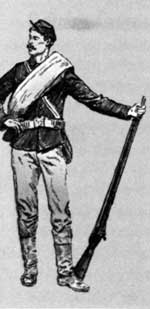|
FORT DAVIS National Historic Site |
 |
The Battle of Rattlesnake Springs
ON AUGUST 2 VICTORIO CROSSED the Rio Grande and collided with a cavalry patrol. Grierson took two troops and rode east to Bass Canyon, near present Van Horn, to intercept the Indians. They doubled back, however, and on August 4 slipped through the screen of soldiers and rode northward on the west side of the forbidding Sierra Diablo range. Grierson found out at once. He raced northward on the east side of the mountains, marching 65 miles in 21 hours, and camped at Rattlesnake Springs. Here Captain Carpenter and two more troops joined him. Posting the entire force under Carpenter a short distance south of the springs, Grierson waited. At 2 in the afternoon the Apaches made their way down Rattlesnake Canyon toward the springs, only to find four troops of cavalry barring the advance. The warriors attacked, but a few volleys from the cavalry carbines scattered them back into the canyon.
 An infantryman of the 1880's, by Rufus Zogbaum. Denver Public Library |
By 4 o'clock the Indians had gathered in the mountains west of the springs. To the southeast, about 8 miles distant, they spied a string of wagons rounding a mountain spur and crawling onto the plain separating the Sierra Diablo from the Delaware Mountains. It was a provision train from Fort Davis guarded by Captain Gilmore and a company of infantry. At once the Apaches rode out of the mountains and attacked. Gilmore met them with a destructive volley. Carpenter, sent by Grierson to help, took the attackers in the rear. They fled in confusion to the southwest and lost themselves in the Carrizo Mountains.
On August 7 Captain Lebo with Troop K reached Rattlesnake Springs. He had cut off a band of Mescaleros from the Guadalupe Mountains riding to join Victorio and forced them back to the north. The next afternoon Captain Baylor and 15 Texas Rangers rode in. Grierson now had most of his command assembled. He divided it into three squadrons of two troops each and set them to combing the mountains for sign of the hostiles. Carpenter and Nolan picked up the trail on August 11, but their horses were too tired and thirsty for rapid pursuit. Nolan's men reached the Rio Grande on August 13. Victorio had crossed the night before.
But not before a parting salute. At Quitman Canyon the Apaches ambushed a stagecoach and killed the driver and the passenger, J. J. Byrne, a Union general in the Civil War, later U.S. Marshal in Galveston, and at the time of his death employed to locate lands in West Texas assigned to the Texas and Pacific Railroad. The bullet struck him in the thigh, reported Ranger Captain Baylor, "within an inch of the wound he received at Gettysburg. We buried him (a mixed crowd of Confederates, citizens, and U.S. soldiers) and fired a couple of volleys over his grave."
Colonel Grierson had not destroyed Victorio. But he had out generaled the greatest of Apache generals and—an accomplishment few others could boast—had prevented him from going where he had planned to go.

|
|
Last Modified: Fri, Oct 18 2002 10:00:00 pm PDT |


